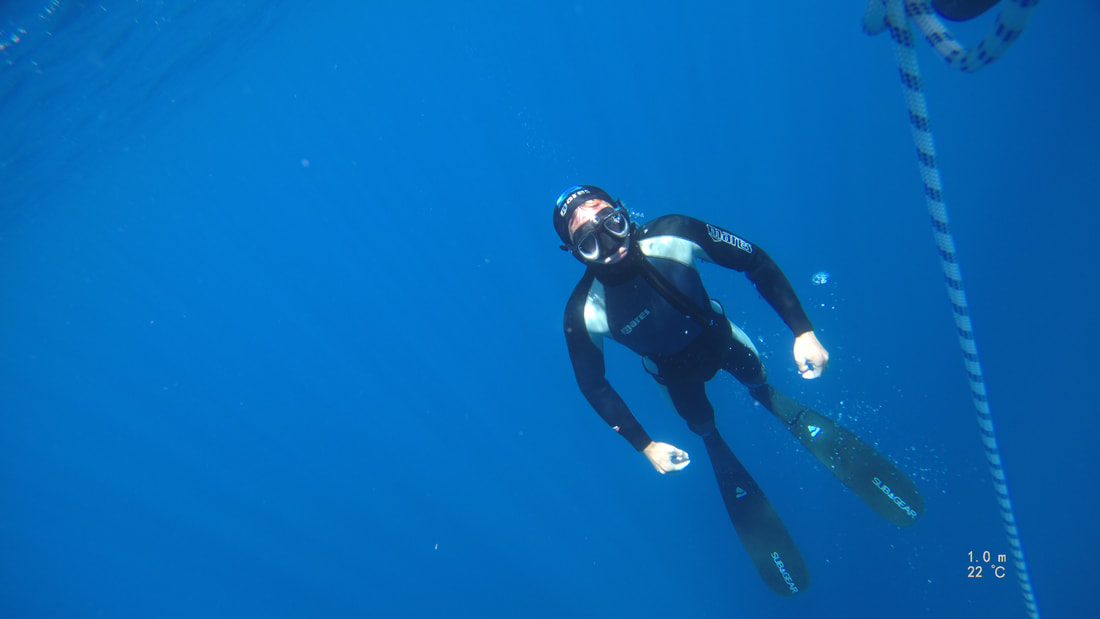Those of you following One Breath Freediving on your social media channels will already know that I have been using the Paralenz dive camera quite extensively already, for both photos and videos, so for this review part 2 (part 1 is un-boxing and initial impressions),I wanted to look at it's use in the water. More than numbers such as pixels and frame rates, I wanted to discuss it's functionality and how well it works specifically from a freediver's point of view.
Firstly, it's primary mount method that I have employed so far with the Paralenz dive camera has been the mask mount. For me this has been the most convenient as I am normallly using it while teaching or guiding. Once the mask attachment is threaded to the mask strap, you clip the camera on using the 'T-Rail' mount system that gives a reassuring double 'click' when properly secured.
The first thing you notice while wearing it in the water is.....that you don't actually notice the camera! Despite feeling substantial and solid when held in the hand, once attached to the mask I can honestly say that I forget that the camera is actually there. Being so non-intrusive is a huge plus for freedivers as we take in the water minimum equipment and definitely don't like things that create drag or resistance.
Functionality from this position is another massive plus. The feedback loop of vibrations of the camera unit, mean that you do not need to remove the camera (and mask) at all to know what setting you are in! For example, rotate the selector ring clockwise while turned on gives one vibration for video, two vibrations for camera, three for settings etc. And then long or short holds of the activation switch can start or stop recording or offer other functions. This creates a simple user and selector operating system and excellent hands free usability.
The first thing you notice while wearing it in the water is.....that you don't actually notice the camera! Despite feeling substantial and solid when held in the hand, once attached to the mask I can honestly say that I forget that the camera is actually there. Being so non-intrusive is a huge plus for freedivers as we take in the water minimum equipment and definitely don't like things that create drag or resistance.
Functionality from this position is another massive plus. The feedback loop of vibrations of the camera unit, mean that you do not need to remove the camera (and mask) at all to know what setting you are in! For example, rotate the selector ring clockwise while turned on gives one vibration for video, two vibrations for camera, three for settings etc. And then long or short holds of the activation switch can start or stop recording or offer other functions. This creates a simple user and selector operating system and excellent hands free usability.
Now lets look at the quality of photos that Paralenz is capable of (for videos, check the OBF YouTube channel). All the snaps in this review were taken from the mask mount position, so just a reach to the side of the head and a short pull on the activation switch can give you some great photos. While primarily a video camera, the photos are surprisingly clear, sharp and lacking in distortion at the edges (as can be common for extremely wide angle cameras). In these photos I had Depth Colour Correction (DCC) turned on and Depth & Temperature overlay turned on. The photo above from 5m displays nice blue water and clear white logos on the wetsuit hood. The first photo handles the reflecting light from the shallow water very well and also created a shot that is not blurred or distorted from the divers movement.
Initial in water conclusions:
- Mask mount is very useful for hands free use
- Unit vibration feedback is a great idea and super useful with mask mount
- Photos lack distortion and are very sharp
- DCC is perfect for multiple depth change diving (such as freediving)



